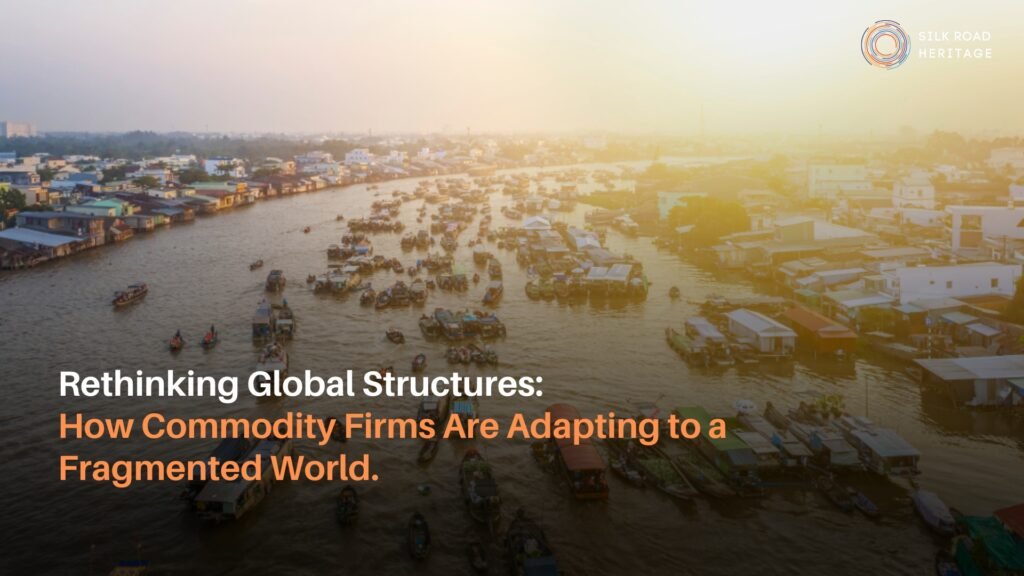Rethinking Global Structures: How Commodity Firms Are Adapting to a Fragmented World.

4/18/2025
The global trade landscape is shifting. Economic nationalism, geopolitical tensions, and evolving regulatory frameworks are reshaping the way businesses operate across borders. For commodity firms—where supply chains span multiple jurisdictions—navigating these changes is not just about survival; it’s about securing a competitive edge.
During a recent panel discussion hosted by the Financial Times in its Commodities Global Summit 2025 with CFOs of leading commodity firms, one theme stood out: the need to reassess global structures in light of increasing fragmentation. The old playbook of centralizing operations in traditional trade hubs is being replaced by a more dynamic, regionally diversified approach.
This shift is being driven by several key factors:
1. Geopolitical Tensions and Trade Fragmentation
Global trade is no longer a seamless, interconnected web. Instead, it is evolving into distinct regional blocs. The U.S.-China trade war, sanctions regimes, and shifting alliances are forcing businesses to reconsider their operational models. One CFO noted that his firm is actively diversifying supply chains away from politically volatile regions to mitigate risk. The traditional reliance on single sourcing is giving way to a more resilient, multi-regional procurement strategy.
2. The Rise of Regional Hubs
The panel discussion highlighted an emerging trend—establishing regional headquarters rather than operating from a single global HQ. One CFO shared how his firm is restructuring its business model, creating distinct operational centers in Asia, the Middle East, and Europe. This not only allows for better regulatory compliance but also enables faster decision-making in response to market fluctuations.
3. Banking and Financial Structures Are Evolving
One of the biggest challenges for multinational firms is navigating financial restrictions, especially in emerging markets. Panelists emphasized that global banking relationships are becoming more fragmented. Sanctions and compliance requirements have led to increasing difficulty in accessing capital and executing cross-border transactions. Some firms are turning to local banking partners and alternative financing models to maintain liquidity in key markets.
4. Compliance and Risk Management as a Competitive Advantage
Regulatory frameworks are becoming more complex, with varying levels of oversight in different jurisdictions. Several CFOs pointed out that proactive compliance is no longer just about avoiding penalties—it’s about building credibility and trust. Companies that can demonstrate robust governance structures are better positioned to secure financing, attract investors, and maintain stable operations in volatile markets.
5. Technology and Digital Infrastructure Are Reshaping Operations
Technology is playing a crucial role in enabling decentralized global structures. Panelists discussed how blockchain, AI-driven trade finance solutions, and real-time compliance monitoring tools are helping firms manage operations across multiple jurisdictions. The ability to leverage digital tools for risk assessment, contract enforcement, and trade documentation is becoming a key differentiator.
What This Means for Businesses in Global Trade
One thing is clear: the traditional model of centralized global structures is becoming obsolete. Businesses that fail to adapt risk being caught in regulatory bottlenecks, financial constraints, and geopolitical upheavals. On the other hand, companies that embrace regional diversification, flexible financial structures, and advanced compliance strategies will be better equipped to thrive in this new reality.
For financial consultancies and trade finance experts, this shift presents an opportunity. As companies look to restructure their global presence, they will require expert guidance on regulatory compliance, risk mitigation, and optimized financial structures. The question now is not whether to adapt but how quickly businesses can restructure to stay ahead.
Silk Road Heritage is a boutique financial and business consulting firm based in the vibrant city of Dubai with branches in Italy and Switzerland.
- 2024 SilkRoadHeritage. All rights reserved.

